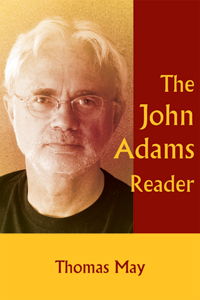|
A USEFUL SURVEY

Thomas May's 'The John Adams Reader',
reviewed by MIKE WHEELER
John Adams is the most wide-ranging composer to have emerged from American minimalism, and therefore much the most interesting. In his early sixties, he is looking increasingly like the natural successor to Aaron Copland and Elliott Carter as the elder statesman of American concert music.
This collection of essays and interviews, by several writers, is divided into four main sections. Part One, 'Portraits of the Artist' gives us an overview of Adams and his place in recent American culture. The editor's introduction emphasises Adams' 'aesthetic openness', and in an interview the composer discusses his early interest in Schoenberg and enthusiasm for Cage, his first encounter with minimalism and his conflicting reactions to Glass.

This is followed by a series of newspaper articles from 2001-3. Joshua Kosman openly describes Adams as 'America's composer laureate' and compares his position with Britten's in the UK (though to say that Britten was 'dragooned' into writing Gloriana and 'felt nothing but impatience' with Vaughan Williams and Elgar is a little off-beam, to say the least). Ingram Marshall fills in some of the details of Adams' experimental 1970s.
Part Two, 'The Musical Works', contains essays, extended programme notes and CD notes on over twenty major works, from Shaker Loops to Doctor Atomic, including such significant scores as Harmonium and the Chamber Symphony. Michael Steinberg's notes for the CD recordings of Nixon in China and The Death of Klinghoffer are given complete, including librettist Alice Goodman's scene-by scene synopses (although for Act 3 of Nixon we only get Steinberg's commentary, for some reason). His programme note for the San Francisco Symphony Orchestra on El Dorado explores its social and political background in some detail, while that on the Violin Concerto examines its composition process. His CD essay on El Niño is followed by an interview with Adams on the same work. Other pieces explore a work's wider ramifications, for instance Ingram Marshall's essay on Adams' 1983 electronic piece Light over water, which examines his collaboration with choreographer Lucinda Childs.
In Part Three, 'Collaborators and interpreters', theatre director Peter Sellars discusses with the editor his work with Adams on Nixon, Klinghoffer, El Niño and Doctor Atomic. Rupert Christiansen, in an article originally published in Opera magazine, examines the work of the third member of the creative team, librettist Alice Goodman. There are interviews with Robert Spano on conducting Adams, with Adams on conducting Ives, with pianist Emanuel Ax on performing Century Rolls, and with soprano Dawn Upshaw on working with Adams on El Niño.
Though this is essentially a celebration of Adams, not a critical study, Part Four, 'Critical reception', the longest of the four sections, includes more detached assessments of Adams' work. The sceptics (indeed, counsels for the prosecution) are Edward Rothstein and Richard Taruskin. In two articles for The New Republic in the 1980s Rothstein dissects what he regards as the flaws in Harmonielehre, Grand Pianola Music and Harmonium, and in Nixon. In a sub-section of seven essays on the controversy surrounding The Death of Klinghoffer, Taruskin, writing in the wake of the 9/11 attacks, takes the Boston Symphony Orchestra's decision to cancel a performance of three choruses from the opera as the starting-point for a discussion of the possibility that in some circumstances art can actually do more harm than good, advocating forbearance rather than censorship by an external agency. This section also includes reactions to Penny Woolcock's Channel 4 film (in which, Mark Swed's article in Part One of the book informs us, Thomas Allen was originally to have played the Captain of the Achille Lauro, the role that eventually went to Christopher Maltman).
This section also contains reviews of works including the Violin Concerto, Century Rolls, El Niño and On the Transmigration of Souls; this is followed by an extended discussion on an art exhibition mounted on the anniversary of 9/11, presumably to give the piece on ...Transmigration... some context, since it doesn't actually touch on Adams or his music directly. Finally we pull back to take in a wider view of Adams' work in an extended excerpt from a book on the composer by French author Renaud Machart.
There are four appendices, containing, respectively: the libretto of a contentious scene from Klinghoffer that was cut after the première; the composer's own synopses of I was Looking at the Ceiling and then I saw the Sky and Doctor Atomic; and a classified list of works up as far as the 2006 opera A Flowering Tree (not considered elsewhere in the book), with details of scoring, first performance and recording catalogue numbers.
I spotted one typo: '...the Chinese invitation to the US Ping-Pong team in 1871...' (p 115), and Bernd Feuchtner attributes the Klinghoffer film to the BBC (p 309).
A useful survey of Adams' music, but one which leaves plenty of scope for a more detailed critical study, illustrated with the musical examples this book so obviously lacks. Nevertheless it fulfils its function as an introduction to one of the major creative figures of our time. In a piece reprinted from The New Yorker, Alex Ross comments 'There is a coiled energy behind his laconic exterior', which also perfectly sums up the latent power of Adams' work.
Copyright © 20 July 2009 Mike Wheeler,
Derby UK
 BOOK INFORMATION: THE JOHN ADAMS READER
CLASSICAL MUSIC BOOK REVIEWS
BOOK INFORMATION: THE JOHN ADAMS READER
CLASSICAL MUSIC BOOK REVIEWS
JOHN ADAMS AMADEUS PRESS DOCTOR ATOMIC NIXON IN CHINA ALICE GOODMAN PETER SELLARS ROBERT SPANO EMANUEL AX DAWN UPSHAW BOSTON SYMPHONY ORCHESTRA THOMAS ALLEN UNITED STATES OF AMERICA
|

